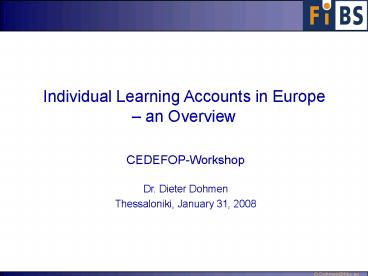FiBS - PowerPoint PPT Presentation
1 / 12
Title: FiBS
1
Individual Learning Accounts in Europe an
Overview
CEDEFOP-Workshop Dr. Dieter Dohmen Thessaloniki,
January 31, 2008
D.Dohmen_at_fibs.eu
2
Content
- ILAs a brief history and a definitionary
approach - 1st generation ILAs real Saving Accounts
- 2nd generation ILAs Individual Learning
Accounts - ILAs/Vouchers for SMEs
- Summary
D.Dohmen_at_fibs.eu
3
2. History and definition
First discussions on ILAs started roughly 10
years ago, e.g. in United Kingdom and
Sweden Basic idea was to establish saving
accounts for LLL however Sweden has not
introduced the model at all and UK established a
different approach In recent years, saving
accounts were introduced (for education in
general) in Austria and, to some extent, in the
Netherlands and discussed in Germany gt
Experience is rather limited and not promising,
if we refer to saving accounts
D.Dohmen_at_fibs.eu
4
2. History and definition
- However, there are many other models that are
called ILA and which are different from saving
accounts - Non-saving ILAs were introduced in UK, the
Netherlands, Belgium, the Basque region, Italy - Some of them operate on an account basis, others
dont - ? What is the core requirement to call an ILA an
ILA? - Is it necessary that it operates via a bank
account (technical approach)? - Or, is it an ILA, if it is called an ILA
(labelling approach)? - Otherwise, the distinction between ILAs,
vouchers, cheques etc. blurs
D.Dohmen_at_fibs.eu
5
3. 1st-Generation Saving ILAs
Real saving accounts were mainly debated, but
not implemented UK and Netherlands Initially,
ILAs were thought off as saving
accounts Sweden Tax-based saving
approach Austria Saving within the home
purchasing savings frame First experience
suggest a rather low usage Explanation Financing
requirements are usually low Limited ability of
long-term planning for further training (which
is a must for higher amounts), Banking systems
interest is very limited
D.Dohmen_at_fibs.eu
6
4. 2nd- generation ILAs
- ILAs for individuals
- Unrestricted models for All
- UK, Austria, Italy, Training cheques in Flanders
(Belgium) - Pilot-models for selected target groups
- The Netherlands, Flanders (Belgium) ILA, Canton
Geneva (Switzerland) - Allocation usually limited
- Co-financing of 150 500 (exceptions
Flanders (Belgium), some regions in Italy) - Sporadically, higher support is available for
selected target groups - e.g. in Austria and Italy
D.Dohmen_at_fibs.eu
7
4. 2nd-generation ILAs Findings
- Take up-rates appear to be relatively modest,
usually, particularly when approach is
country-wide - Often, a gap exists between accounts opened and
accounts utilized - Average costs of further professional training
are rather modest with up to 500 (due to low
funding or low costs?) - Share of female participation is often above
average - Positive correlation of take-up rates and
socio-economic factors or professional status
D.Dohmen_at_fibs.eu
8
4. 2nd-generation ILAs Findings
- Severe mobilisation effects, but also deadweight
loss can be identified - Deadweight loss might be reduced, if approach is
clearly directed at certain target groups (e.g.
income restrictions, unemployment) - Quality assurance, information and advice are
very important frame conditions to ensure proper
function of ILAs (in fact, are important for any
market driven or demand-led approach) - Public relations seems an important factor,
particularly to reach lowly-educated or difficult
to reach target-groups - Involving banks is costly and, thus, debatable.
D.Dohmen_at_fibs.eu
9
5. Vouchers for SMEs in Belgium
Vouchers/ILAs can be applied for companies as
well SMEs in both regions (Flanders and Wallony)
can buy up to (max. 400) vouchers with a value of
30 at a price of 15 Target Increasing
participation level to 20 hrs per
employee Achieved 1.400 SMEs utilized the scheme
with the first year
D.Dohmen_at_fibs.eu
10
5. Small Firms Development Account in UK
Companies with 5 to 49 employees could
participate Identification of a training
champion who was responsible for developing of a
structured training plan, with support of a
training consultant 50 of the training costs,
max. 225 were covered by a grant Findings
Funds ranged from 135 to 28,500 (average
amount 3,000) Companies with 5-10 employees
were under-represented Only 2 of companies had
not participated in training so far Advice and
support in developing training plans seems
particularly important for SMEs
D.Dohmen_at_fibs.eu
11
6. Summary
Real saving accounts dont seem to be
appropriate ILAs can be applied to individuals
and SMEs empirical evidence is positive though
pointing at some weaknesses (need for
action) Take-up rates and average costs (per
measure) are mainly limited Quality assurance,
information and advice are very important
add-ons It seems possible to target certain
groups, if properly addressed However, how do we
distinguish between ILAs and other modes, e.g.
vouchers? Do we need to distinguish?
D.Dohmen_at_fibs.eu
12
Individual Learning Accounts in Europe an
Overview
CEDEFOP-Workshop Dr. Dieter Dohmen Thessaloniki,
January 31, 2008
D.Dohmen_at_fibs.eu






























